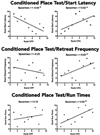On the positive and negative affective responses to cocaine and their relation to drug self-administration in rats
- PMID: 25662610
- PMCID: PMC4465857
- DOI: 10.1007/s00213-015-3873-6
On the positive and negative affective responses to cocaine and their relation to drug self-administration in rats
Abstract
Rationale: Acute cocaine administration produces an initial rewarding state followed by a dysphoric/anxiogenic "crash."
Objective: The objective of this study was to determine whether individual differences in the relative value of cocaine's positive and negative effects would account for variations in subsequent drug self-administration.
Methods: The dual actions of cocaine were assessed using a conditioned place test (where animals formed preferences for environments paired with the immediate rewarding effects of 1.0mg/kg i.v. cocaine or aversions of environments associated with the anxiogenic effects present 15-min postinjection) and a runway test (where animals developed approach-avoidance "retreat" behaviors about entering a goal box associated with cocaine delivery). Ranked scores from these two tests were then correlated with each other and with the escalation in the operant responding of the same subjects observed over 10 days of 1- or 6-h/day access to i.v. (0.4 mg/inj) cocaine self-administration.
Results: Larger place preferences were associated with faster runway start latencies (r s = -0.64), but not with retreat frequency or run times; larger place aversions predicted slower runway start times (r s = 0.62), increased run times (r s = 0.65), and increased retreats (r s = 0.62); response escalation was observed in both the 1- and 6-h self-administration groups and was associated with increased CPPs (r s = 0.58) but not CPAs, as well as with faster run times (r s = -0.60).
Conclusions: Together, these data suggest that animals exhibiting a greater positive than negative response to acute (single daily injections of) cocaine are at the greatest risk for subsequent escalated cocaine self-administration, a presumed indicator of cocaine addiction.
Keywords: Cocaine; Cocaine addiction; Conditioned place test; Drug abuse; Drug aversion; Drug reward; Drug self-administration; Extended access; Operant runway; Opponent processes.
Conflict of interest statement
The authors have no conflicts of interest to report.
Figures








Similar articles
-
Comparison of self-administration behavior and responsiveness to drug-paired cues in rats running an alley for intravenous heroin and cocaine.Psychopharmacology (Berl). 2011 Apr;214(3):769-78. doi: 10.1007/s00213-010-2088-0. Epub 2010 Nov 18. Psychopharmacology (Berl). 2011. PMID: 21086116 Free PMC article.
-
Prior extended daily access to cocaine elevates the reward threshold in a conditioned place preference test.Addict Biol. 2014 Sep;19(5):826-37. doi: 10.1111/adb.12053. Epub 2013 May 1. Addict Biol. 2014. PMID: 23634951 Free PMC article.
-
Weakening of negative relative to positive associations with cocaine-paired cues contributes to cue-induced responding after drug removal.Pharmacol Biochem Behav. 2012 Jan;100(3):458-63. doi: 10.1016/j.pbb.2011.10.006. Epub 2011 Oct 8. Pharmacol Biochem Behav. 2012. PMID: 22005601 Free PMC article.
-
Opponent process properties of self-administered cocaine.Neurosci Biobehav Rev. 2004 Jan;27(8):721-8. doi: 10.1016/j.neubiorev.2003.11.009. Neurosci Biobehav Rev. 2004. PMID: 15019422 Review.
-
Cracking the molecular code of cocaine addiction.ILAR J. 2011;52(3):309-20. doi: 10.1093/ilar.52.3.309. ILAR J. 2011. PMID: 23382145 Review.
Cited by
-
Innate cocaine-seeking vulnerability arising from loss of serotonin-mediated aversive effects of cocaine in rats.Cell Rep. 2023 May 30;42(5):112404. doi: 10.1016/j.celrep.2023.112404. Epub 2023 Apr 20. Cell Rep. 2023. PMID: 37083325 Free PMC article.
-
Nalmefene is effective at reducing alcohol seeking, treating alcohol-cocaine interactions and reducing alcohol-induced histone deacetylases gene expression in blood.Br J Pharmacol. 2016 Aug;173(16):2490-505. doi: 10.1111/bph.13526. Epub 2016 Jul 18. Br J Pharmacol. 2016. PMID: 27238566 Free PMC article.
-
Impact of the Aversive Effects of Drugs on Their Use and Abuse.Behav Neurol. 2022 Apr 20;2022:8634176. doi: 10.1155/2022/8634176. eCollection 2022. Behav Neurol. 2022. PMID: 35496768 Free PMC article. Review.
-
Methylone pre-exposure differentially impacts the aversive effects of MDPV and MDMA in male and female Sprague-Dawley rats: Implications for abuse vulnerability.Pharmacol Biochem Behav. 2022 Oct;220:173470. doi: 10.1016/j.pbb.2022.173470. Epub 2022 Oct 4. Pharmacol Biochem Behav. 2022. PMID: 36206863 Free PMC article.
-
Adult rat ultrasonic vocalizations and reward: Effects of propranolol and repeated cocaine administration.J Psychopharmacol. 2024 Nov;38(11):1025-1041. doi: 10.1177/02698811241268894. Epub 2024 Aug 12. J Psychopharmacol. 2024. PMID: 39129423 Free PMC article.
References
-
- Ahmed SH, Koob GS. Transition from moderate to excessive drug intake: change in hedonic set point. Science. 1998;282:298–300. - PubMed
-
- Ahmed SH, Koob GF. Long-lasting increase in the set point for cocaine self-administration after escalation in rats. Psychopharmacology (Berl) 1999;146:303–312. - PubMed
-
- Ahmed SH, Kenny PJ, Koob GF, Markou A. Neurobiological evidence for hedonic allostasis associated with escalating cocaine use. Nat Neurosci. 2002;5:625–626. - PubMed
-
- Barbieri EJ, Ferko AP, DiGregorio GJ, Ruch EK. The presence of cocaine and benzoylecgonine in rat cerebrospinal fluid after intravenous administration of cocaine. Life Sci. 1992;51:1739–1746. - PubMed
-
- Bardo MT, Rowlett JK, Harris MJ. Conditioned place preference using opiate and stimulant drugs: A meta-analysis. Neurosci Biobehav Rev. 1995;19:39–51. - PubMed
Publication types
MeSH terms
Substances
Grants and funding
LinkOut - more resources
Full Text Sources
Other Literature Sources
Medical

